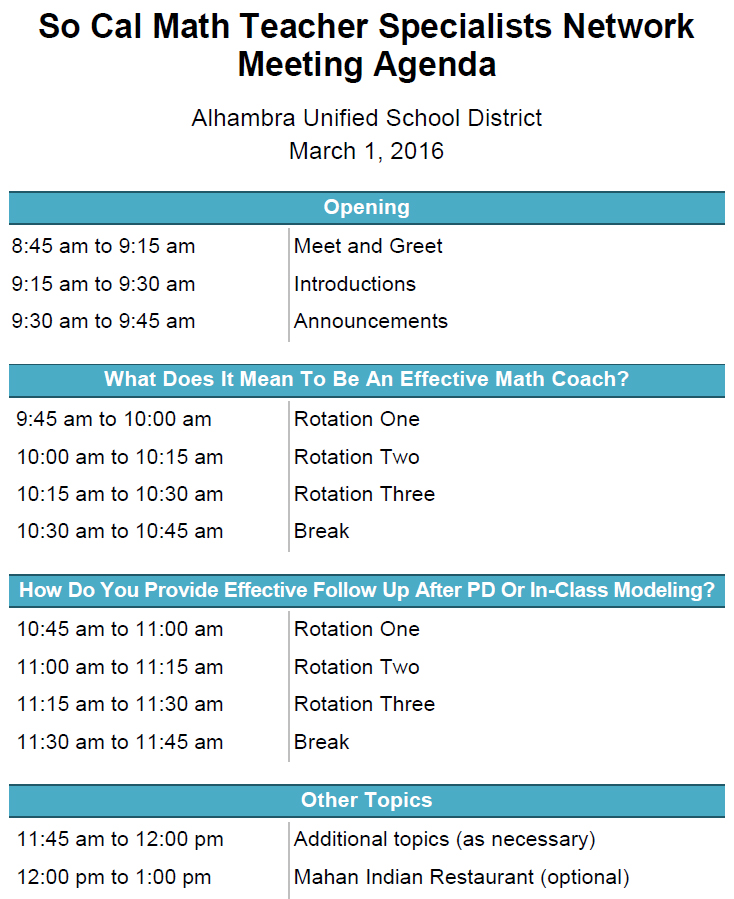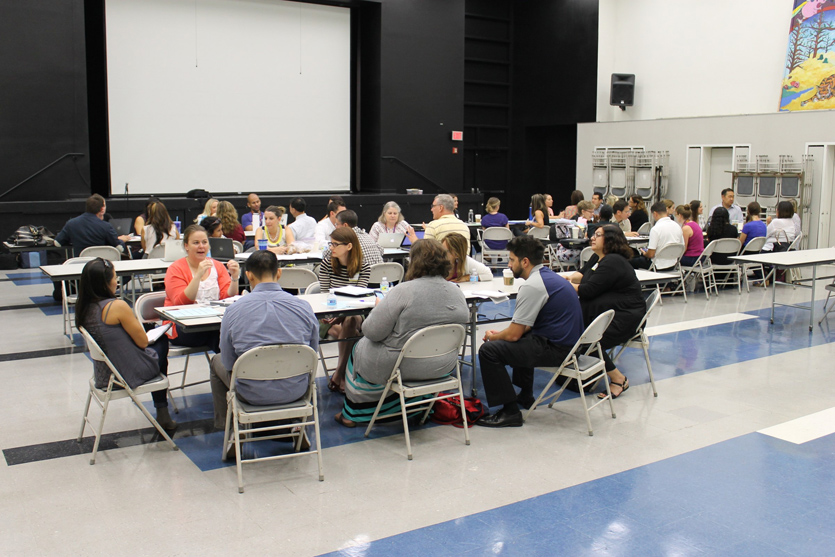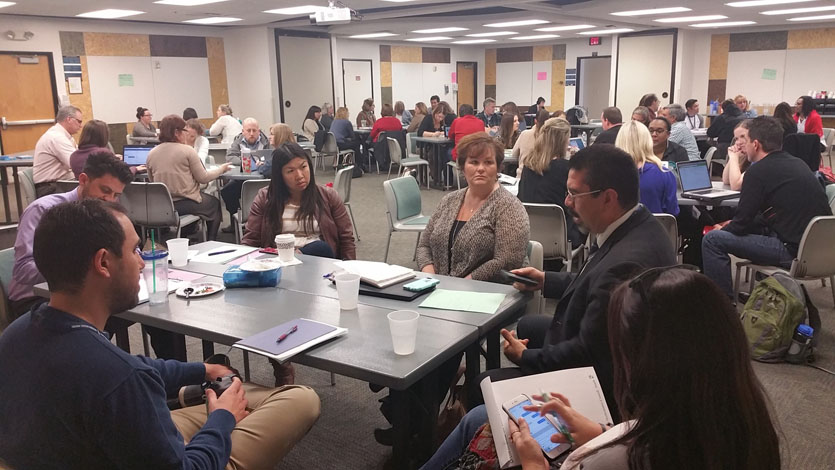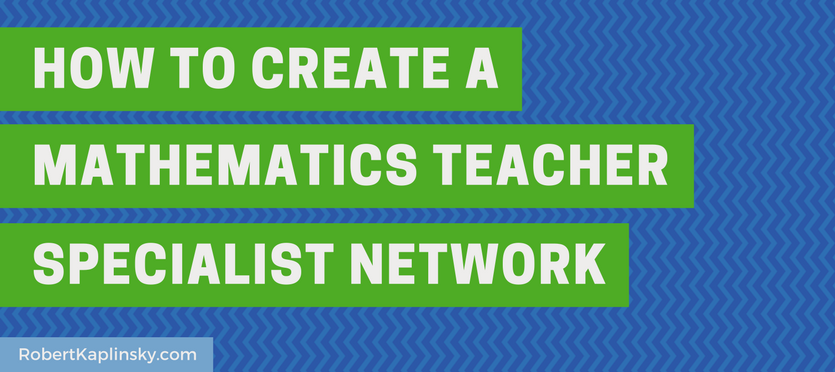This is part four of a series of six posts on how to create a mathematics teacher specialist network. Find the entire series here.
The first three parts of this series described why you would want a network like this, how to begin creating your network, and what to do before you have your first meeting. This post will describe what to do during your meeting and will cover:
- Agenda
- Seating arrangements
- Meeting facilitator
- Professional development source
- Sharing out
- Creating meeting minutes

They all “begin” at 8:45 am, primarily because we are such a spread out group that it sometimes takes people two hours to get to a meeting, and starting right at 8:00 am is not practical. The reality is that they really begin at 9:15 with the Introductions. However, since so much of life is about the relationships you make, the “Meet and Greet” time is crucial for making connections. I typically spend this time saying hello to old and new friends, but I also spend this time trying to introduce people that may not know each other but should. Some examples of this include:
- Two teacher specialists that work in neighboring school districts.
- Two teacher specialists from districts that are using the same textbook (and may find collaboration especially useful)
- A representative from a regional or county organization and someone who he or she may not know but is in his or her service area
The network is only as strong as the connections people feel to it, so if you see anyone coming to a meeting who is new or who doesn’t seem to know anyone, it is everyone’s responsibility to change that as quickly as possible. You don’t want anyone to feel like they don’t belong.
For the Introductions, we usually go around the room and say our name, our school district / employer, and our position. Sometimes when we have lots of new people we also ask everyone to raise their hand if they’ve been in their position for two years or less. This had been at least 40% of the group, so it made people feel like they were not the only one who was new. Also, Introductions never actually take 15 minutes, but you will absorb those minutes later.
For the Announcements (which also never actually takes 15 minutes), people often have events or information to share including:
- Upcoming local, state, or national conferences
- Courses or higher education opportunities at local universities
- Professional development going on at local venues
Regarding the “Professional development going on at local venues,” sometimes this is something you have to pay for, but sometimes it is free too. For example, in Downey Unified School District (where I work full time), we have had Eric Milou and Steve Leinwand come present. When they came, we invited everyone from our network because it was an obvious win/win/win:
- The presenters win because they get more publicity (and other districts that may now invite them)
- The other teacher specialists win because they get free professional development
- The teachers in my district win because they become increasingly interested in a presenter who they may have never heard of but is apparently popular/important enough that teacher specialists from all over the area are excited to come see him or her.
Next in the agenda come the rotations where teacher specialists discuss the topics they voted on in the “Future Topics of Interest” (discussed in more detail here under “Choosing topics to discuss at these meetings”). The topics are almost always the two topics with the highest overall scores. The only exceptions have come when the topics were internet based (such as “Online math resources”) and the venue had no WiFi. In those cases we picked the next highest scoring topic and saved the skipped topic for the following meeting.
For each topic there are three rotations that are fifteen minutes each. The reality is that each rotation usually runs long, and the extra time left over from the Introductions and Announcements gets used up here. More on this in a bit.
After the two topics are discussed in sets of three rotations, we end with bringing up Additional Topics. This is often extra announcements that people forgot to mention earlier but also includes Sharing Out, which will also be discussed in a bit.
Lastly, we always go out to lunch after the meeting to continue the discussions. On average, about 50% of the attendees go to lunch and many great ideas have spawned out of the conversations had there.
Here’s a picture from our very first meeting. We chose to sit as a massive circle because we didn’t want it to look like someone was the leader. We wanted to make sure that even the physical layout of the room showed that we were all equals, in this together. At this point we didn’t have rotations, so when we discussed a topic, we went all around the room and took turns, one by one. It better resembled a series of mini-speeches than a discussion. As you can imagine, it took an agonizing amount of time to get around the room so you could respond.

Learning from our experiences, we decided to break the larger group into three smaller groups: K-5, 6-12, and K-12 & other. We figured that now we would be small enough to have conversations. As the picture below from our second meeting illustrates, what we did not think about what how large the 6-12 group was and how small the K-5 and K-12 & other groups were. I’m guessing that you can figure out from the picture which one was the 6-12 group. We had, in effect, the same problem from the first meeting. It still took an agonizing amount of time to go around the table and we didn’t have enough time to share our thoughts. At the smaller table, they had the opposite problem and got done quickly with little to talk about. We learned two things from this meeting:
- Something about our seating arrangement structure had to change drastically
- We had to get a huge influx of elementary teacher specialists or we would lose that demographic entirely because they would feel it was a waste of their time

We have no pictures of our third meeting, but it was at that meeting that we made a huge step forward. We realized that as much as we wanted to be able to hear what everyone in the group had to say, it was untenable. So, we decided to change our structure from one 45-minute conversation to three 15-minute rotations. We also made many smaller groups of 4 to 8 people (4 to 6 is ideal). The advantage of these smaller groups was that you actually got to have legitimate conversations. The downside was that you didn’t get to hear everyone’s ideas.
The basic structure was that the secondary teachers would sit towards one half of the room and the elementary teachers would sit towards the other. K-12 teachers could pick either. You would sit in groups of 4 to 8 (smaller is more intimate) and after 15 minutes you would switch groups and hopefully find mostly new teachers to sit with.
The three pictures below are from meetings after rotations went into effect.



The structure has more or less remained the same since the third meeting. The only exception is that J.J. Martinez suggested that for the first two rotations we stay within our grade bands but for the third rotation, everyone mixes. So, for example, a secondary math teacher specialist would sit with other secondary math teacher specialists for the first two rotations. Then in the final rotation, the secondary math teacher specialist will sit with a mix of elementary and secondary math teacher specialists. This structure has worked very well for us and we have used it ever since.
Regarding the lack of elementary math teacher specialists, the way we resolved it was by openly discussing it at every meeting and asking (begging?) everyone to contact any elementary math teacher specialist they know and invite them to the meeting. This worked well and we have come as far as having meetings with more elementary math teacher specialists than secondary math teacher specialists.
Also, when people discuss a topic where they have handouts, they often make quite a few copies for everyone they expect to talk to but they also post them electronically in the Edmodo group after the meeting so that people can download them there as well.
Generally what this looks like is right before the meeting starts I talk with whoever is hosting the meeting and go through the agenda with them. He or she will then call everyone together at 9:15 and explain how the introductions will go, ask about announcements, explain how the rotations will work, tell everyone when the 15 minutes is up (though sometimes a digital timer gets projected instead), and then wraps it all up. If the meeting facilitator has any questions, he or she can look to you to chime in. Now you can be an assistant and not the leader. It pretty much always goes well.
About two years later, Nanette Johnson suggested that we could end by sharing out our “one favorite thing” verbally. This is now something we do during the “Additional Topics” time. We discuss our one favorite thing for the first topic and then the second topic. This leads to…
What do you think? Any suggestion for improving this process?

